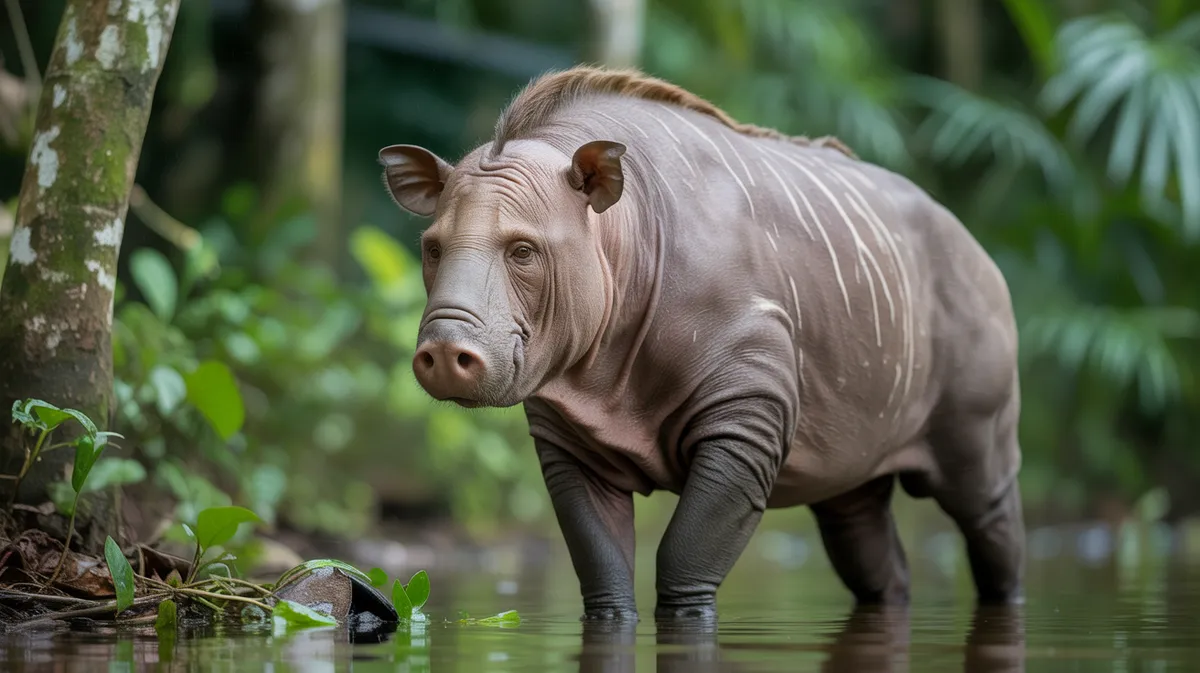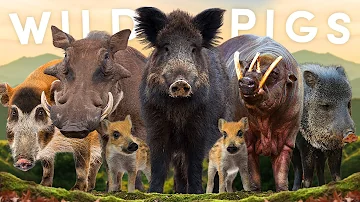
Babirusa
Babyrousa celebensis

Meet the Babirusa
The Babirusa is a unique wild pig native to the Indonesian islands of Sulawesi, Togian, Sula, and Buru. It is instantly recognizable by the remarkable upward-curving tusks of the males, which can grow through the skin of the snout and curve back toward the forehead. Babirusas inhabit tropical rainforests, swamps, and riverine forests, often near water sources. They are omnivorous, feeding on a mix of fruits, leaves, roots, and small animals. Due to habitat loss and hunting, their populations are declining, and many species are classified as vulnerable or endangered.
Classification
Mammal
Habitat
Tropical rainforest and swamp forests
Diet
Omnivore
Lifespan
10-24 years
Conservation
Vulnerable
Weight
40-100 kg
📖Fascinating Facts
Extraordinary Tusks
Male babirusas have upper canine teeth that grow upward through the skin of the snout and can curl back toward the forehead.
Island Endemic
Babirusas are found only on a few Indonesian islands, making them endemic to this region.
Water Lovers
Babirusas are often found near rivers and swamps, and are excellent swimmers capable of crossing wide stretches of water.
📋Detailed Description
The North Sulawesi babirusa (Babyrousa celebensis) is a medium-sized suid, with adult males typically weighing 60–100 kg and measuring 85–110 cm in body length, with a shoulder height of 65–80 cm. Its most distinctive feature is the male's extraordinary upper canines, which grow upward through the snout and curve back toward the forehead, sometimes reaching lengths of 30 cm. These tusks are composed of elongated canine teeth and are thought to play a role in social display and possibly in intraspecific combat, though they are relatively fragile and not well-suited for digging or fighting. The babirusa has a relatively hairless, grayish skin, often appearing wrinkled and covered in sparse bristles. Its legs are long and slender compared to other pigs, giving it a somewhat deer-like appearance. Babirusas are primarily diurnal, foraging during the early morning and late afternoon. They are excellent swimmers and are often found near rivers, swamps, and other water bodies. Their diet is omnivorous, including fruits, nuts, leaves, roots, invertebrates, and occasionally small vertebrates. Socially, babirusas are generally found in small groups, often consisting of females and their young, while adult males are more solitary or form loose bachelor groups. Vocalizations and scent marking play important roles in communication. The species is endemic to the Indonesian island of Sulawesi and some nearby islands, inhabiting dense tropical rainforests, riverine forests, and swampy lowlands.
💡 Did you know?
Babirusas are one of the few wild pig species where the males' tusks can actually curve back and pierce their own heads if they are not broken or worn down naturally.
🔬Research & Sources
Wikipedia Summary
The babirusas, also called deer-pigs, are a genus, Babyrousa, in the swine family found in the Indonesian islands of Sulawesi, Togian, Sula and Buru. All members of this genus were considered part of a single species until 2002, the babirusa, B. babyrussa, but following that was split into several species. This scientific name is restricted to the Buru babirusa from Buru and Sula, whereas the best-known species, the North Sulawesi babirusa, is named B. celebensis. The males have prominent upwards incurving canine tusks, which pierce the flesh in the snout.
Last Modified: 5/4/2025
🎭Behavior & Social Structure
Babirusas are primarily crepuscular, being most active during dawn and dusk. They spend much of their time foraging for food, using their sensitive snouts to root through soft soil and leaf litter. Unlike other wild pigs, babirusas rarely dig with their tusks, relying instead on their snouts and forelimbs. They are known to wallow in mud or water to regulate body temperature and deter parasites. Social groups, called sounders, are typically matriarchal, with females and offspring forming stable units, while adult males are more solitary except during the breeding season. Babirusas communicate through a range of vocalizations, including grunts, squeals, and snorts, as well as through scent marking using specialized glands. Agonistic encounters between males involve head-to-head pushing and display of tusks rather than direct combat. They are cautious and elusive, retreating quickly into dense vegetation when disturbed.
👶Reproduction & Life Cycle
Babirusas exhibit a polygynous mating system, with dominant males seeking access to receptive females during the breeding season, which may occur year-round but often peaks with the onset of the rainy season. Courtship involves vocalizations, scent marking, and ritualized displays. After mating, the gestation period lasts approximately 150–158 days (about 5 months). Females give birth to litters of 1–2 piglets, which is notably small compared to other suids. Newborns are precocial, able to stand and follow the mother within hours of birth. The mother constructs a nest of vegetation for the piglets, which remain hidden for the first few weeks. Weaning occurs at 6–8 months, and sexual maturity is reached at around 2 years of age. Parental care is provided solely by the female.
🛡️Adaptations & Survival
The babirusa's most striking adaptation is the male's upward-curving tusks, which are unique among mammals. These tusks are thought to serve as visual signals in male-male competition and possibly as protection for the face during confrontations, though their fragility suggests a primary role in display. The species' elongated legs and reduced body hair are adaptations for moving quietly and efficiently through dense, humid forest undergrowth. Babirusas have a highly flexible snout and mobile lips, allowing them to manipulate a wide variety of food items. Their digestive system is adapted to process both plant and animal matter, reflecting their omnivorous diet. Behavioral adaptations include wallowing and swimming, which help regulate body temperature and avoid parasites in the tropical environment.
🎨Cultural Significance
Babirusas hold a unique place in local folklore and mythology in Sulawesi. The name 'babirusa' means 'pig-deer' in Indonesian, reflecting the animal's unusual appearance. In some indigenous traditions, babirusas are regarded as mystical creatures, and their tusks have been used as charms or status symbols. Historically, babirusa meat has been consumed by local communities, though this is less common today due to religious dietary restrictions and conservation awareness. The animal's distinctive form has inspired art and carvings in the region.
🔬Recent Research & Discoveries
Recent genetic and morphological studies have clarified the taxonomy of the genus Babyrousa, leading to the recognition of multiple distinct species rather than a single, widespread one. Ongoing research focuses on population genetics, reproductive biology, and the ecological impacts of habitat fragmentation. Camera trap surveys and non-invasive genetic sampling are being used to estimate population densities and monitor trends. Studies on tusk development have provided insights into sexual selection and evolutionary adaptation. Conservation programs are increasingly involving local communities in habitat protection and anti-poaching efforts.
🎥Wildlife Videos

The Bizarre World of Babirusas: Nature's Oddities
Dive into the fascinating world of babirusas, nature's most intriguing oddities! In this documentary, we'll explore the unique ...
World Wonders

Babirusa - 5 Minute Documentary
Venture into the lush forests of Indonesia with a captivating five-minute documentary on the Babirusa, a remarkable creature often ...
Five Minute Documentaries

Male Babirusa have a Dominance Dance-off! | Nature Bites | Secret Life of the Zoo
Male Babirusa, Tolo, has his eye on one particular female, however, her brother does not approve. Will Tolo manage to seal the ...
Nature Bites

The Babirusa
This is a video of the babirusa taken from the BBC's Life of Mammals.
globalzoo

All 20 Wild Pig Species (& Their Piglets!)
Explore all 20 species of wild pigs, where they live and what makes them unique. This video includes both Old and New World ...
Textbook Travel

Meet the Strangest Pigs in the World
Separated from the mainland, the babirusa pigs of Sulawesi have evolved in total isolation. This has resulted in some pretty ...
Smithsonian Channel
🌍Habitat Information
The Babirusa typically inhabits Tropical rainforest and swamp forests environments. Babirusas have adapted to their environments with specialized features and behaviors.
Primary Habitat:
Tropical rainforest and swamp forests
More detailed habitat information will be available soon.
🛡️Conservation Status
The Babirusa is currently classified as Vulnerable. Conservation efforts are crucial for preserving this species for future generations.
Common Threats:
- 🏠Habitat loss and fragmentation
- 🌡️Climate change impacts
- 🎯Hunting and poaching
- 🏭Human-wildlife conflict
⚠️Threats & Conservation Challenges
Babirusas face a range of threats, primarily from habitat loss due to deforestation, agricultural expansion, and infrastructure development on Sulawesi and surrounding islands. Illegal hunting for meat and trophies, as well as capture for the exotic pet trade, further reduces populations. Fragmentation of habitat isolates groups, making them more vulnerable to local extinction. Population estimates are difficult due to their elusive nature, but trends indicate a continuing decline. The IUCN lists Babyrousa celebensis as Vulnerable, with some local populations considered Endangered. Conservation challenges include weak law enforcement, limited protected areas, and ongoing human encroachment. Inbreeding and loss of genetic diversity are additional concerns for small, isolated populations.
🔬Scientific Classification
Scientific Name
Babyrousa celebensis
Classification Hierarchy
🔍 About Taxonomic Classification
Taxonomic classification is a hierarchical system used by scientists to classify and organize living organisms based on shared characteristics and evolutionary relationships.
The system moves from broad categories (Kingdom) to increasingly specific ones, with each animal's scientific name typically consisting of its Genus and species.
📝Community Notes
Share your observations and insights about the Babirusa with our community of wildlife enthusiasts.
Join Our Community
Sign in to share your observations and connect with fellow wildlife enthusiasts.
Sign In to ContributeNo community notes yet
Be the first to share your observations about the Babirusa!
Explore Babirusa
Select a tab above to learn more about this amazing animal.
📸Photo Gallery
No photos available for this animal yet.
🌟Discover More Wildlife
Continue your journey of discovery with more fascinating animals from our database
